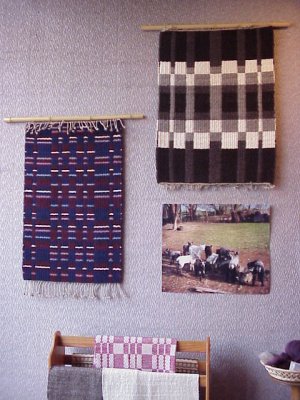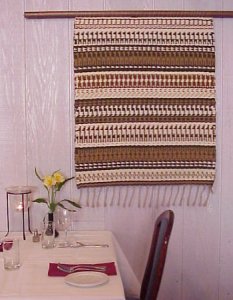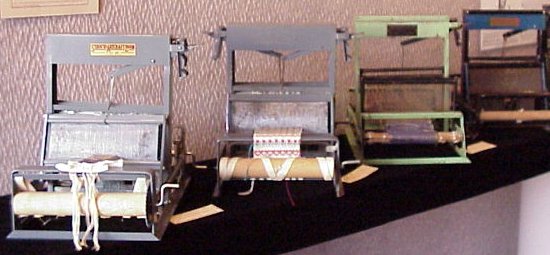| Artist's Statement - NANETTE
MOSHER
As a child, living in Virginia with my
grandmother, I watched her weave rag rugs on the Union 36 loom which I
now possess. I learned to crochet with leftover warp, and marveled
at the "fancy" evening bags she wove from the 8" Structo four harness
loom now in my loom room. But I didn't think much about this until,
as an adult, I moved to Freeport, IL, and the YMCA offered a class
in weaving--which happened to be taught on Structo floor looms--made in
Freeport. So, I took up weaving, and before long fell heir to Mom's
looms.
| Then, I read The Joy of Spinning (by Marilyn
Kluger, Simon and Shuster, 1971) and found a peaceful, relaxing way to
feel as if I had really "made something from scratch"--inspired at
the time by projects for a graduate level craft class. And wool to
sort, wash, card and spin was easy to come by: farmer friends even
had "black" sheep as well as white ones, and invited me to come watch the
shearing and choose fleeces. I soon realized that there are many
aspects that make big differences in any wool to be handspun. Color,
length, hay or burrs in the wool, "sheep berries", variations in
coarseness or fineness, all make a difference in how much fun it is to
work with any single fleece. Even roving, already prepared for spinning,
which by then was on the market commercially, can have disappointing surprises. |
 |
About that time we moved to the "country"--five
miles from town, with fences and outbuildings. Guild friends, including
Mary Boeke Hill, guided and encouraged my timid eagerness to have my own
sheep. It only took a few seasons to settle on what was, for me,
the ideal spinning fleece on the ideal breed of sheep, carefully fed and
sheared to produce the fleeces used in most of my spinning and much of
my weaving. The fact that these animals are also my pets gives me
justification, perhaps, in practicing this anachronistic craft.

:
|

(close-up of rug to the
left)
|
Design aspects of any loom-woven object are
by definition controlled by the loom. Frustrated by the limitations
of Mom's two harness rug loom, I purchased an 8-Harness 45" Gilmore Loom,
which was used for all of the rugs on display
here. (Weavers will note that only 4 of the harnesses were used in
the rugs.) Planning a 2 -block Summer and Winter structure,
I spun and wove one rug for the "Save the Sheep" project of Interweave
Press, using a British long-wool rare breed. For comparison, I did
a similar rug using the natural colored wool from my own Cheviot sheep.
Because spinning the yarn for a rug is no small project, most of the rugs
on exhibit are woven from commercial yarns which have, in most cases, been
re-plyed and re-dyed to obtain the desired weight and color. Many
are in straight twill weave, with patterns derived from the use of multiple
colors and bound weave sett. The use of twill is actually an idea
that came from the use of bound weave Rosepath patterning on the 8"
Structo loom (a structure not directly suitable for rugs because
of the long "floats" on the back).
Even though the articles displayed here
may seem quite unrelated, there is really a continuum of heritage, chance,
opportunity and experience that links them all, from looms and antique
advertisements to miniature overshot coverlets and heavy twill rugs.
I greatly appreciate The Dining Room's creative approach in giving Mary
Boeke Hill and me the opportunity to show these looms and handwovens. |



